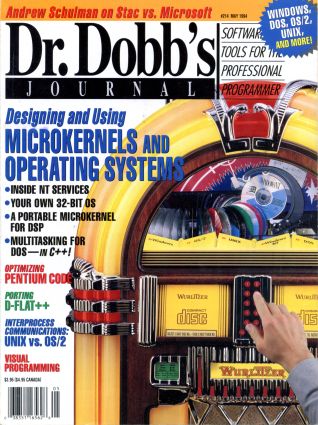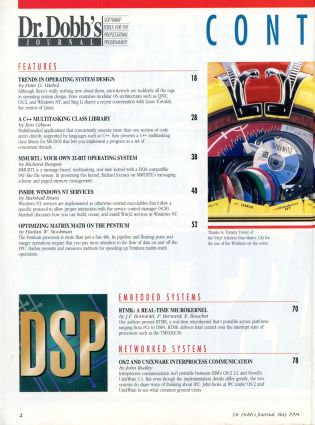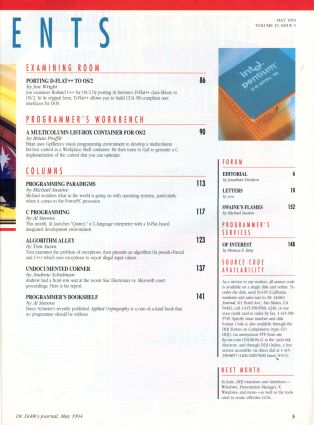
p.6 EDITORIAL
[author : Jonathan Erickson] #Edito
TABLE OF CONTENTS
FEATURES
p.18 TRENDS IN OPERATING SYSTEM DESIGN
[author : Peter D. Varhol]
Although there's really nothing new about them, microkernels are suddenly all the rage in operating system design. Peter examines modular OS architectures such as QNX, OS/2, and Windows NT; and Sing Li shares a recent conversation with Linus Torvalds, the creator of Linux.
p.28 A C++ MULTITASKING CLASS LIBRARY
[author : Ken Gibson]
Multithreaded applications that concurrently execute more than one section of code aren't directly supported by languages such as C++. Ken presents a C++ multitasking class library for MS-DOS that lets you implement a program as a set of
p.38 MMURTL: YOUR OWN 32-BIT OPERATING SYSTEM
[author : Richard Burgess]
MMURTL is a message-based, multitasking, real-time kernel with a DOS-compatible FAT-like file system. In presenting this kernel, Richard focuses on MMURTL's messaging scheme and paged-memory management.
p.48 INSIDE WINDOWS NT SERVICES
[author : Marshall Brain]
Windows NT services are implemented as otherwise-normal executables that follow a specific protocol to allow proper interaction with the service control manager (SCM). Marshall discusses how you can build, create, and install Win32 services in Windows NT.
p.52 OPTIMIZING MATRIX MATH ON THE PENTIUM
[author : Harlan W. Stockman]
The Pentium processor is more than just a fast 486. Its pipeline and floating-point and integer operations require that you pay more attention to the flow of data on and off the FPU. Harlan presents and measures methods for speeding up Pentium matrix-math operations.
EMBEDDED SYSTEMS
p.70 RTMK: A REAL-TIME MICROKERNEL
[author : J.F. Bortolotti, P. Bernard, E. Bouchet]
Our authors present RTMK, a real-time microkernel that's portable across platforms ranging from PCs to DSPs. RTMK delivers total control over the interrupt state of processors such as the TMS320C30.
NETWORKED SYSTEMS
p.78 OS/2 AND UNIXWARE INTERPROCESS COMMUNICATION
[author : John Rodley]
Interprocess communication isn't portable between IBM's OS/2 2.1 and Novell's UnixWare 1.1. But even though the implementation details differ greatly, the two systems do share ways of thinking about IPC. John looks at IPC under OS/2 and UnixWare to see what common ground exists.
EXAMINING ROOM
p.86 PORTING D-FLAT++ TO OS/2
[author : Jon Wright]
Jon examines Borland C++ for OS/2 by porting Al Stevens's D-Flat++ class library to OS/2. In its original form, D-Flat++ allows you to build CUA '89-compliant user interfaces for DOS.
PROGRAMMER'S WORKBENCH
p.90 A MULTICOLUMN LIST-BOX CONTAINER FOR OS/2
[author : Brian Proffit]
Brian uses GpfRexx's visual-programming environment to develop a multicolumn
COLUMNS
p.113 PROGRAMMING PARADIGMS
[author : Michael Swaine]
Michael wonders what in the world is going on with operating systems, particularly when it comes to the PowerPC processor.
p.117 C PROGRAMMING
[author : Al Stevens]
This month, Al launches "Quincy," a C-language interpreter with a D-Flat-based integrated development environment.
p.123 ALGORITHM ALLEY
[author : Tom Swan]
Tom examines the problem of exceptions, then presents an algorithm (in pseudo-Pascal and C++) which uses exceptions to report illegal input values.
p.137 UNDOCUMENTED CORNER
[author : Andrew Schulman]
Andrew had a front-row seat at the recent Stac Electronics vs. Microsoft court proceedings. Here is his report.
p.141 PROGRAMMER'S BOOKSHELF
[author : Al Stevens]
Bruce Schneier's recently published Applied Cryptography is a one-of-a-kind book that no programmer should be without.
FORUM
p.10 LETTERS
[author : you]
p.152 SWAINE'S FLAMES
[author : Michael Swaine]
PROGRAMMER'S SERVICES
p.148 OF INTEREST
[author : Monica E. Berg]

